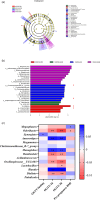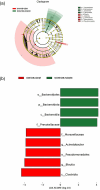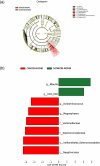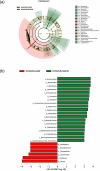Association of gut microbiota with overweight/obesity combined with gestational diabetes mellitus
- PMID: 40366751
- PMCID: PMC12282309
- DOI: 10.1099/jmm.0.002010
Association of gut microbiota with overweight/obesity combined with gestational diabetes mellitus
Abstract
Introduction. Gestational diabetes mellitus (GDM) is one of the most common complications of pregnancy and negatively affects the health of mothers and infants. The aim of this study was to explore the associations between gut microbiota and the risk of GDM amongst overweight/obese women, and the interaction between gut microbiota dysbiosis and overweight/obesity in pregnant women with GDM.Hypothesis/Gap statement. Previous studies revealed that there may be a link between gut microbiota and GDM and obesity, but these studies have not reported the associations between gut microbiota and the risk of GDM amongst overweight/obese women, whilst the interaction between gut microbiota dysbiosis and overweight/obesity in pregnant women with GDM remains unknown.Aim. Based on a prospective cohort study, we explored the composition of gut microbiota in overweight/obese pregnant women and its association with GDM.Methodology.Participants (n=1820) were enrolled from the Pregnancy Metabolic Disease and Adverse Pregnancy Outcome cohort in Guangzhou, China, between 2019 and 2021. The participants' information and faecal samples were collected, and the relative abundance of faecal microbiota was profiled using 16S rRNA V4 region sequencing. Pregnant women were divided into four groups: non- overweight (NOW)/obese without GDM (OB- NGDM), overweight (OW)/OB- NGDM, NOW/obese with GDM (OB- GDM) and OW/OB- GDM. Linear discriminant analysis effect size (LEfSe) analysis, Spearman's correlation analysis and t- test were performed to estimate the association amongst microbiota, pre- pregnancy BMI and oral glucose tolerance test (OGTT) glucose levels.Results. Blautia, Anaerostipes, Synergistes (P<0.001) and Christensenellaceae_R_7_group (P=0.007) were significantly different between NOW/OB-GDM and OW/OB-GDM groups after adjusting for age. Odoribacter, Anaerostipes, Monoglobus, Romboutsia, Oscillospiraceae__UCG-003, Blautia and Dialisterwere significantly correlated with both OGTT 1 h (P<0.001) and 2 h (P<0.05) blood glucose levels, whilst Lactobacillus(P<0.001) were significantly correlated with OGTT 2 h blood glucose levels. Synergistes(P<0.001) were significantly correlated with OGTT fasting glucose levels, and Megasphaera and Odoribacter(P<0.05) were significantly correlated with pre-pregnancy BMI.Conclusions. GDM and OB/OW women was experiencing microbiota dysbiosis, especially the microbial communities related to glucose metabolism.
Keywords: gestational diabetes mellitus; gut microbiota; obesity; overweight.
Conflict of interest statement
The authors declare that there are no conflicts of interest.
Figures







References
-
- Hiden U, Lassance L, Tabrizi NG, Miedl H, Tam-Amersdorfer C, et al. Fetal insulin and IGF-II contribute to gestational diabetes mellitus (GDM)-associated up-regulation of membrane-type matrix metalloproteinase 1 (MT1-MMP) in the human feto-placental endothelium. J Clin Endocrinol Metab. 2012;97:3613–3621. doi: 10.1210/jc.2012-1212. - DOI - PubMed
MeSH terms
Substances
LinkOut - more resources
Full Text Sources
Medical
Miscellaneous

